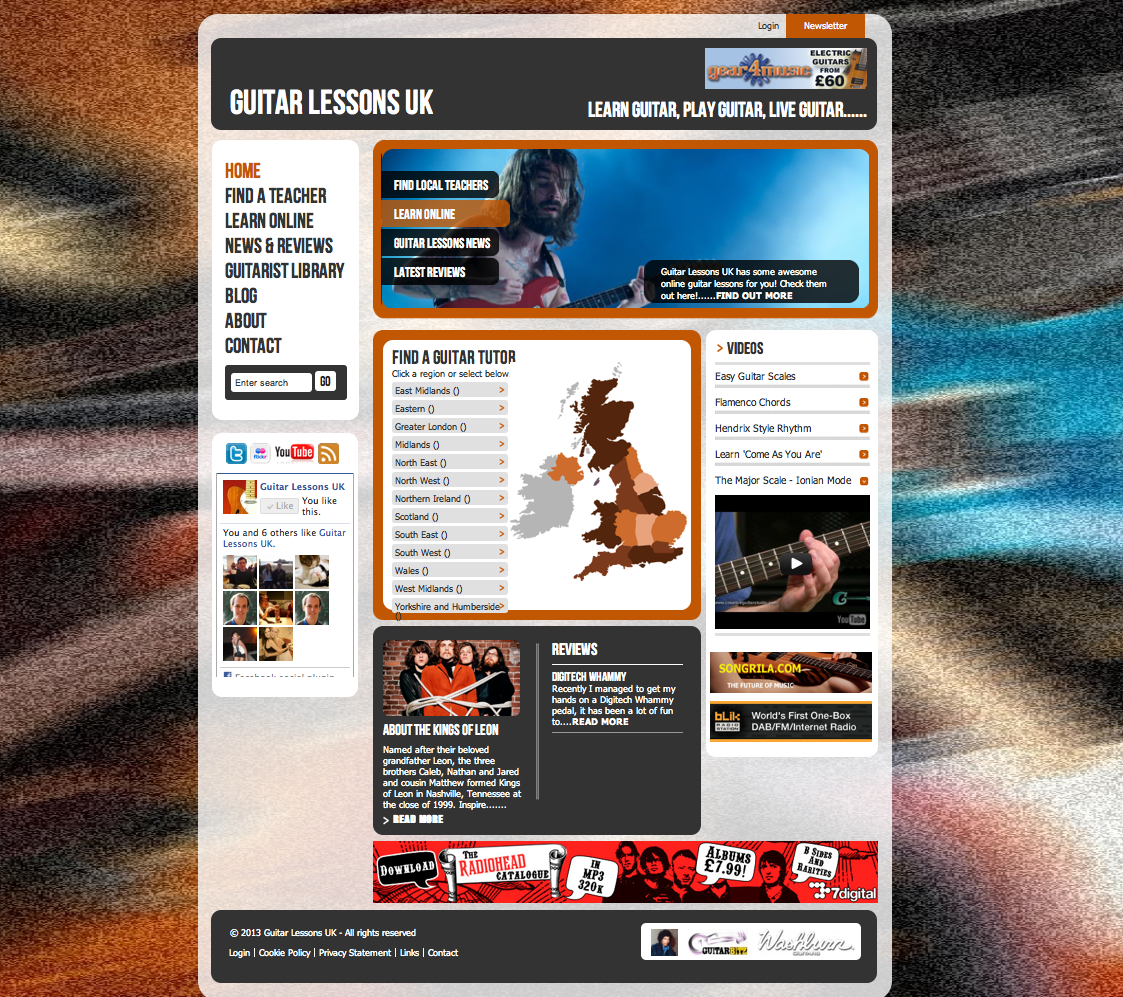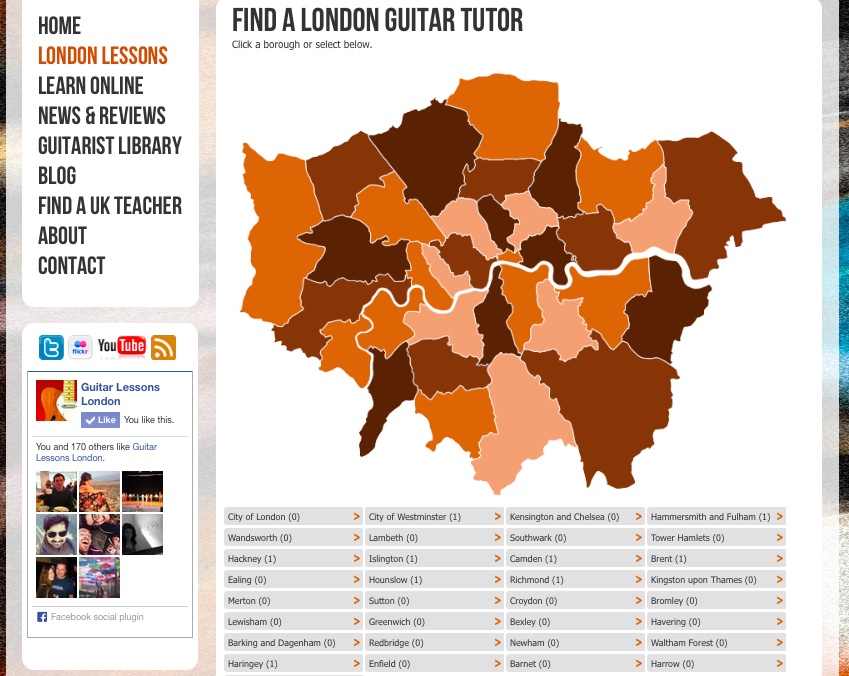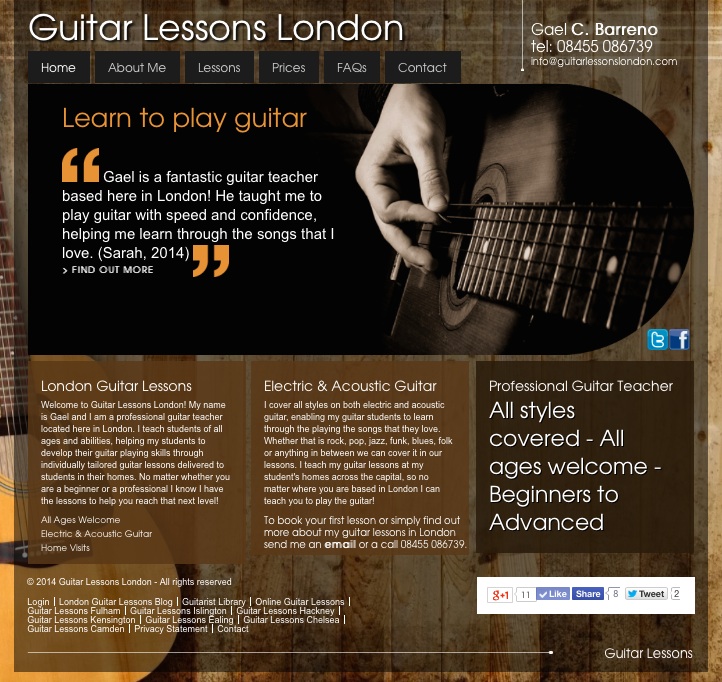I thought exactly one year to the day when I launched Guitar Lessons London I thought I would write a short personal update on its development, a story of pivoting, entering the most competitive music tuition market in the UK and constant development to appeal to an audience that is like nowhere else in the UK. Originally rather than a Guitar Lessons London website the site was targeted at the entirety of the UK, under a “Guitar Lessons UK” branding with subpages for different teachers within locations – yet it quickly proved inefficient in generating the number of enquiries needed to support multiple guitar teachers across the nation.

Guitar Lessons London – originally launched under the a ‘Guitar Lessons UK’ branding
Therefore, when the opportunity arose to move into the London guitar tuition market – a dream of mine since launching my music tuition business in first year of university – I pounce upon it, purchasing the www.guitarlessonslondon.com domain name and rebranding the website to “Guitar Lessons London”.
However, this quickly struck a problem as with a UK map potential students only had the very smallest of areas to click on to locate their teachers, so with the help of Andy from 1010 Media we decided to include a borough by borough map of London as the focus of the websites homepage. Whenever you design a website you have to be really clear about the customers journey through that website, once a potential client is on your website how are you going to get the from A (the first page they view) to B (a purchase, enquiry, content viewing, email subscription page depending on your aims for the website). For the music tuition websites the aim is to get them to enquiry via a contact form so having a clear customer journey for this new look Guitar Lessons London website was key: (i) landing page (ii) click on borough on map (iii) select teacher (iv) read about teacher (v) contact.

Guitar Lessons London – second design, with London borough map
Yet, after this update was launched the truth was it simply didn’t work! How could this be? Well, the truth was this had disturbed a central theme that had helped the success of all of the other music tuition website; primarily that each website was designed for one teacher, creating a personalised experience for a potential student that didn’t give them more choices to make about which teacher they wanted. I found that providing potential students with a multitude of teachers actually decreased enquiry rates as a client simply wanted one teacher that looked professional, friendly and able to teach them the music that they wanted to learn. There was a second cold point that we quickly learned – that even 5 clicks from landing page to enquiry was too many to ask of the majority of web users who went through this thought process: (i) enter a website, does it look good? (ii) looks good, read a little info (iii) sounds good, I will enquire – making it a three step process. And a final third point was that by presenting a multitude of teachers the website gave the impression that it was a music agency rather than a personalised website ran by a great guitar teacher – a quick search for “Guitar Lessons London” on Google would show that my direct competitors all presented in the same manor: a music agency with teachers, rather than individual teachers running their own website. This meant that my website simply didn’t stand out from the rest – no wonder the enquiries were so low despite the best of intentions when we launched the second design update!
So despite all the hard work, as well in investment in this second design, in February 2014 I decided to develop a new model where the website replicated the normal locational website templates with a “lead teacher” who could deliver lessons to students within their own homes across London to see if I could increase enquiry numbers. Implementing this template would make the website much more personal, hopefully improving enquiry numbers through a model that had already been proven across the UK. Another huge time investment this third updated came into place and I quickly saw a rapid increase in the number of enquiries coming through the website – yet it was still way off what I would expect for the number of searches made per month in London for guitar lessons.

Guitar Lessons London – third design, personalised to a single ‘lead teacher’
Clue another step back and analysis of the analytics of the websites – turns out the Londoners spend even less time on the websites that in other cities across the UK, meaning basically even if they liked the website that they didn’t have the time/motivation/patients to get to the final “Contact Me” page. Ever heard of “London service” – turns out the same is true on the internet! (Why wouldn’t it be?!) So to combat this I decided to additionally put a contact form on every one of the pages that I want a client to work through when they land on the website, everything from the “About Me” page to the “Prices” page. This again dramatically increased the number of enquiries coming through the website – yet is it finished, certainly not! There is still plenty to develop on the website over the next year or so to help to increase the conversion numbers of the people entering the website to completing the target action desired by the webmaster. I have found that nothing ever stands still on the internet, it is an ever evolving field where a inconveniently placed link or one click too many will half the number of conversions you will make – but what am I complaining, I would do just the same on your website and so would you!
Connect with Matthew via LinkedIn or have a read of his personal blog, where this week he wrote the Ultimate Guide to Single Malt Scotch.
Posted under 1010 Media, Guitar Lessons London, MGR Music, Progress Update
This post was written by
Deprecated: get_the_author_url is deprecated since version 2.8.0! Use get_the_author_meta('url') instead. in /var/www/html/wp-includes/functions.php on line 5213
Matthew Rusk on April 17, 2014
